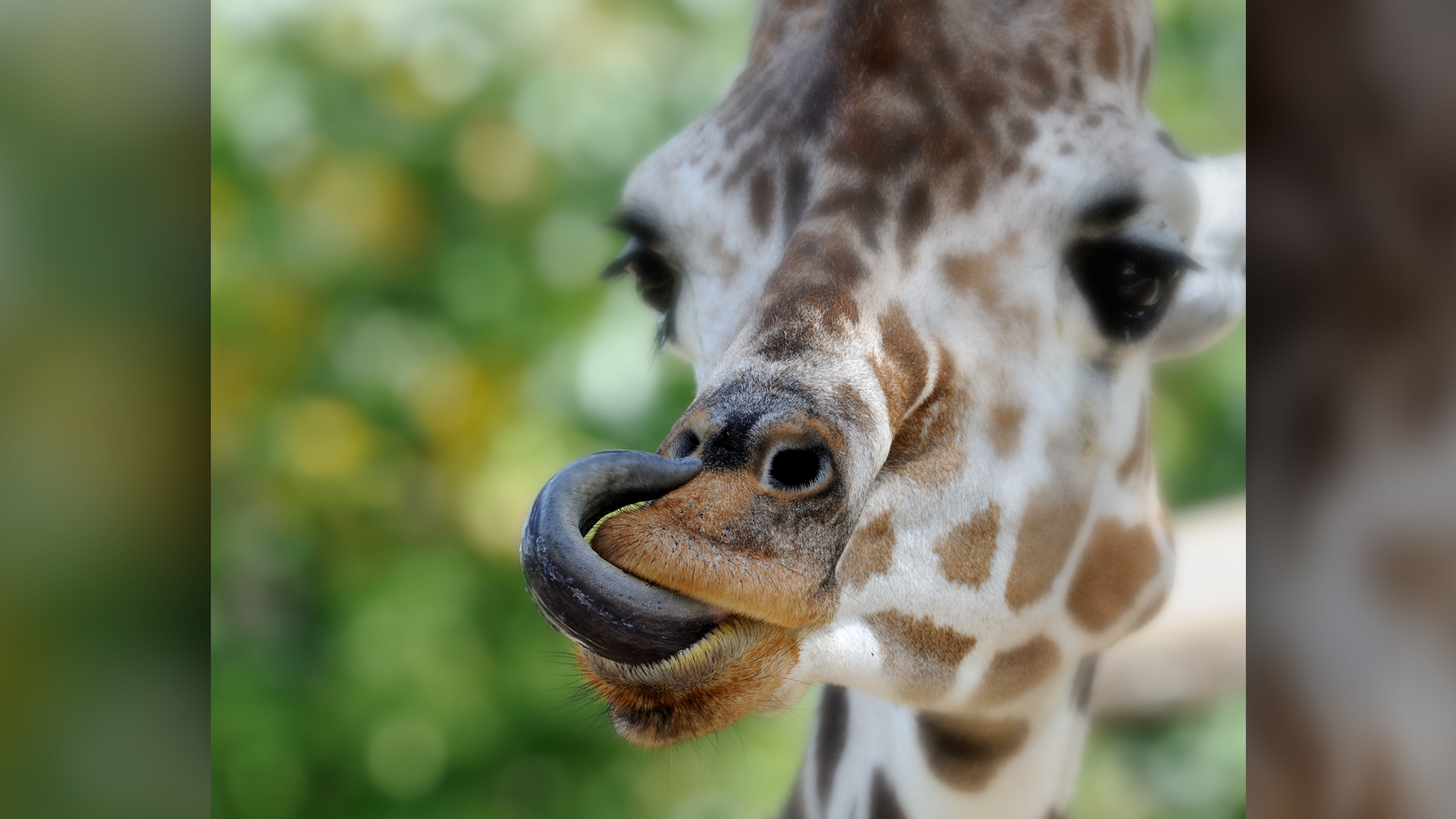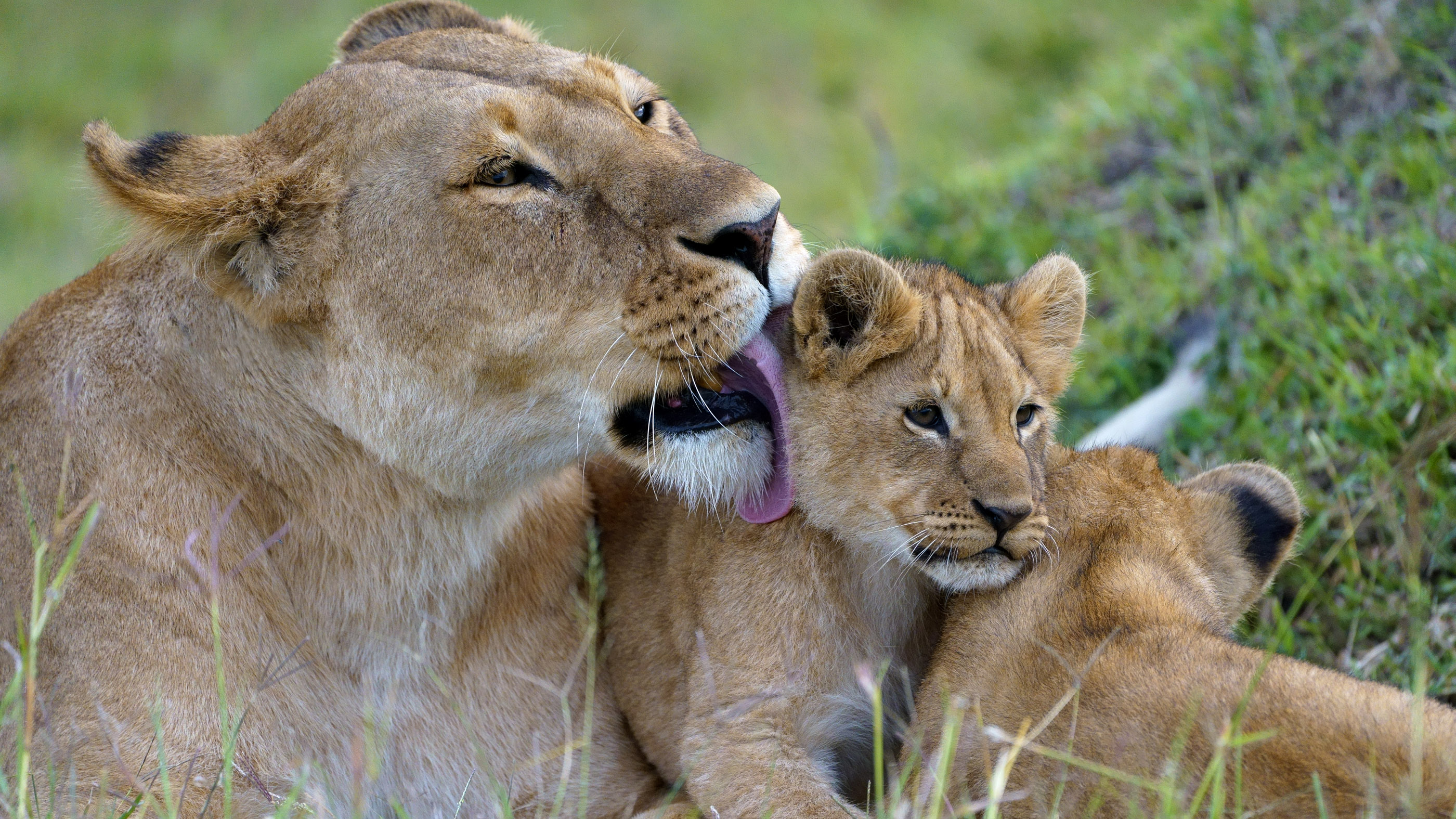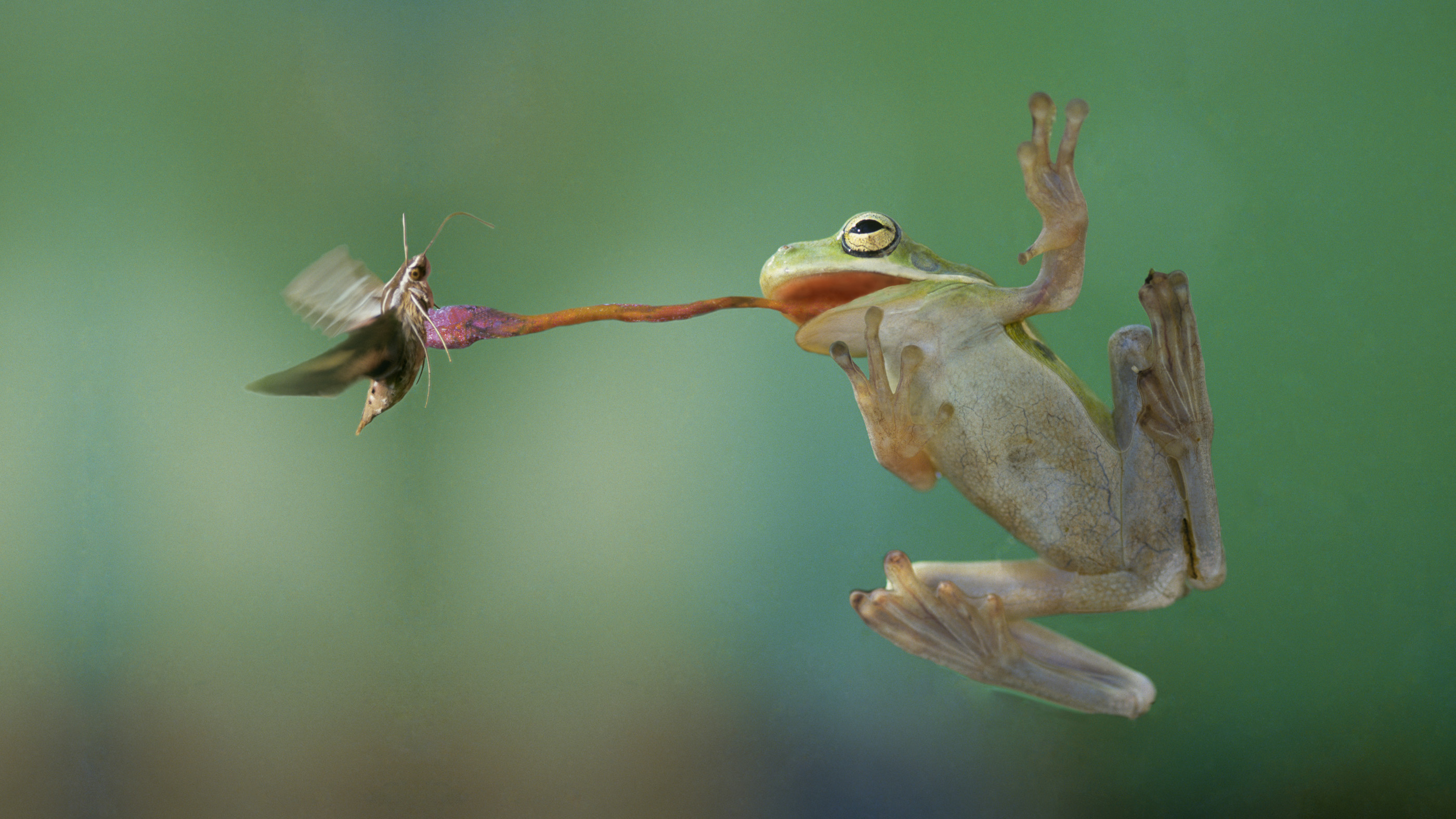
Don't underestimate the tongue, a muscular organ that humans use for licking, breathing, tasting, swallowing and speaking. But this organ varies widely in color, shape, length and function across the animal kingdom. Whereas human tongues are pink and typically just over 3 inches (7.6 centimeters) long, the anteater has a 2-foot-long (60 cm) tongue and the blue-tongued skink has a brilliant blue one.
Here's a look at 20 amazing animal tongues and the science behind them.
Giraffes

If you've ever seen a giraffe's impressive 21-inch-long (53 cm) tongue, you'll know that it's not pink. Rather, the tallest living animal in the world has a dark-colored tongue that looks like a mix of purple, blue and black. That's because giraffes (genus Giraffa) tongues are covered with a lot of the pigment melanin, which acts as a type of sunblock to protect the licker while it reaches for tender leaves.
Giraffes have such long tongues that they can even use them to clean out their ears, according to Mental Floss.
Gila monsters

The Gila monster (Heloderma suspectum) lives up to the "monster" part of its name with its forked tongue. It's thought that the gila's forked tongue helps it smell in "three dimensions," meaning that the two tips can pick up the same odor and then distinguish the wafting chemical gradients in the air, which, in turn, helps the reptile zero-in on the location of the smell's source, Andrew Durso, a herpetologist at Florida Gulf Coast University, wrote in The Conversation.
When the venomous lizard gets hungry, it flicks its sensitive tongue in and out, picking up chemical information about its surroundings. Then, the Gila monster's Jacobson's organ, a part of the olfactory (smelling) system in its nasal chamber, analyzes this information, letting the lizard know whether potential prey, such as small mammals, frogs, lizards, rodents and insects, are nearby.
Pangolins

As the only known mammal with scales, pangolins are weird creatures. Their sticky tongues are just as strange. The pangolin's tongue is connected not to the bottom of its mouth, but to the bottom of its ribcage. When it's not busy snatching up insects, such as ants and termites, the tongue hangs out in the pangolin's chest cavity.
When the pangolin's tongue is extended, it can measure up to 16 inches (40 cm) long, or longer than the animal's head and body combined, according to the BBC.
Sun bears

"The tongue of the sun bear (Helarctos malayanus) is surprisingly long, measuring up to 10 inches (25 cm), according to Guinness World Records. This feature helps the bear channel its inner Winnie the Pooh; its lengthy tongue can extract honey from beehives, a trick that landed it the nickname of "honey bear," according to National Geographic.
Hippos

Much of the hippo's evolutionary history remains shrouded in mystery, according to National Geographic. Their giant tongues are no exception. In a 2010 study published in the journal The Anatomical Record, researchers looked at the tongues of a young and old common hippopotamus (Hippopotamus amphibius amphibius) with scanning electron microscopy and conventional light microscopy. (The 49-year-old female hippo's tongue was 24 inches (60 cm) long, while the 4-year-old male's was 18 inches (45 cm) long.)
The team found that hippo tongues have features similar to a few types of animals: odd-toed ungulates (such as donkeys, which digest plant cellulose in the intestines, not the stomach), ruminants (such as cattle, which have four-chambered stomachs) and omnivorous, non-ruminant mammals (such as pigs, which have simple stomachs).
Meanwhile, hippos use their three-chambered stomachs to help them digest grass. The animal's herbivorous diet and unique evolutionary history may explain "these mixed morphological features of the tongue," the researchers wrote in the study.
Penguins

Which tongue has more bristles than a hairbrush? It's none other than the penguin's.
The penguin's tongue does not have taste buds, but it does have loads of bristles made out of keratin, the fibrous protein that makes up human hair and nails. These bristles help the penguin grab wriggly krill and fish, according to the Smithsonian.
Red-bellied woodpeckers

Woodpecker tongues — made of bone, cartilage and muscle — need to be really, really long so the birds can nab grubs hiding deep in trees. But a woodpecker's mouth isn't big enough to house that long tongue. So, what's the workaround? When it's not in use, the tongue goes into "self storage" by wrapping around the woodpecker's skull.
"The cordlike base of the tongue extends back out of their mouth on each side, winding behind and onto the top of their head, sometimes extending so far forward that it reaches the nostril," Larry Witmer, a professor of anatomy and paleontology with the Department of Biomedical Sciences at Ohio University, told Live Science. "When they need to unleash the weapon, the tongue basically unwinds from around the head to project into a crevice to capture its prey. It's a remarkable mechanism that's evolved independently in several kinds of birds, including hummingbirds."
You can check out this video of Witmer describing a red-bellied woodpecker skull and tongue.
Tongue-eating parasites

This technically isn't a real tongue; it's a parasite that destroys a fish's tongue and then becomes a "substitute" tongue. In other words, this bug-like creature (Cymothoa Exigua) is a tongue-eating parasite.
After the parasite enters through the fish's gills, it latches onto the tongue with its seven pairs of legs and (brace yourself) begins to feed on the tongue like a vampire. Soon, the tongue withers and drops off, but the parasite remains, masquerading as the fish's new tongue.
Lions

Just like other cats, the mighty lion (Panthera leo) uses its tongue to groom its fur. Feline tongues are very effective combs; they're covered with tiny spines known as papillae, which are sharp, hollow and curved backward toward the cat's throat, according to a 2018 study in the journal Proceedings of the National Academy of Sciences. These spines help the cat deliver cleansing saliva to its fur, which later cools the cat as it evaporates.
Cats don't care whether their prey tastes sweet, however. Their tongues have a useless version of the gene Tas1r2, which encodes proteins that combine to form sugar-detecting sensors on the tongue, National Geographic reported.
Giant leaf-tailed geckos

Watch out! If the giant leaf-tailed gecko (Uroplatus fimbriatus) feels threatened, it will make sure you do, too. When this gecko is disturbed, it opens its jaws wide, flashing its bright red mouth and tongue before it releases a piercing distress call that sounds just like a child's scream, Smithsonian's National Zoo reports.
Frogs

Frogs are famous for their fast tongues, and for good reason. More than 4,000 frog species can grab objects with their tongues faster than the human eye can blink, according to Alexis Noel, a research engineer at the Georgia Tech Research Institute who studies frog and cat tongues, previously reported on her website. She noted that frog mouths have a unique anatomy: "Unlike humans, frog tongues are connected at the front of the lower jaw, rather than at the back of the throat."
In addition to its speed, the frog tongue is strong. The tongue of the horned frog can pull objects that are about 1.4 times the frog's body weight, a 2014 study in the journal Scientific Reports found.
Blue-tongued skinks

Blue-tongued skinks, natives of Australia and New Guinea, use their vibrant blue tongue to startle predators, according to the San Diego Zoo. When threatened, the skink puffs up its body so that it appears larger, opens its mouth and hisses while it sticks out its tongue.
Eagles

Eagles have tongues with backward-facing barbs called "rear-directed papillae," which help them swallow prey, according to the Center for Conservation Biology, a research group at the College of William and Mary and the Virginia Commonwealth University. When eagle parents are feeding their young, they use their tongues to help keep away large bones, furry chunks and sharp fins that could cause the chicks to choke, according to the Raptor Resource Project, a nonprofit bird group based in Iowa.
Alligator snapping turtles

The alligator-snapping turtle (Macrochelys temminckii) has a clever trick; it uses its little pink tongue as a fishing lure. While these turtles are known to forage for food along the bottoms of rivers, lakes and swamps, they can also lie still with their mouths open and tongues wriggling, as they wait to ambush fish that mistake their tongues for worms, according to the Nonindigenous Aquatic Species program of the U.S. Geological Survey.
Parrots

How do parrots and parakeets (a type of parrot) mimic human speech? It turns out that Polly can adjust her nimble, muscular tongue so that it modulates the sound coming from her voice box, according to Science magazine. In one small experiment, repositioning the tongue of five dead monk parakeets (Myiopsitta monachus), whose vocal tracts were connected to speaker systems, led to changes in pitch and loudness, which is key for forming vowels in speech, according to a 2004 study in the journal Current Biology.
Emperor tamarins

While humans might take note of the emperor tamarin's distinctive mustache, its fellow emperor tamarins (Saguinus imperator) may have their eyes on something else: the tongue. When these primates are displeased, they tend to flick their tongues, quickly moving the tongue in and out of the mouth, according to Apenheul Primate Park, a zoo in the Netherlands. The emperor tamarin also communicates with shrill calls, chirps, hisses and facial expressions, which, combined with tongue flicking, help keep its troop together and alert to danger, according to the New England Primate Conservancy.
Flies

That hairy appendage dangling out of a fly's mouth may look like a tongue, but it's not. Scientists call it the labellum, and it's the primary taste organ for the Drosophila fruit fly, according to a report from Indiana Public Media. The labellum is attached to the fly's straw-like proboscis, which allows the pest to slurp up food. A word to the wise: Put your leftovers away if you've got a fly problem. These buzzing beasties puke saliva and digestive juices onto food before eating it, because these acids dissolve the food the fly wants to suck up, according to HowStuffWorks.
Giant anteater

The giant anteater (Myrmecophaga tridactyla) doesn't have teeth, but it doesn't need them; instead, it uses its roughly 2-foot-long (60 cm) tongue to eat up to 30,000 ants and termites a day, according to the San Diego Zoo. This narrow and spaghetti-like tongue, which is attached to the mammal's sternum, is covered with tiny, backward-pointing spines and sticky saliva to help it grab the tiny insects. The anteater's tongue is fast, too — it can dart in and out of its mouth up to 150 times a minute.
Chameleons

Chameleons are relatively slow creatures, but their 20-inch-long (50 cm) tongues are fast enough to catch speedy insects, such as locusts, mantids and grasshoppers. The tip of the chameleon's tongue is a ball of muscle, and once it hits prey, that ball transforms into a suction cup. The instant the prey is stuck, the reptile draws its tongue back into its mouth, where its strong jaws crush the catch, according to the San Diego Zoo.
Hummingbirds

Hummingbird tongues were misunderstood for more than 180 years, until a 2015 study set the record straight. Initially, scientists thought that hummingbird tongues used capillary action — in which liquid can flow through narrow channels, even against gravity — to pull up floral nectar. But actually, these tongues act as elastic micropumps, according to the journal Proceedings of the Royal Society B: Biological Sciences.
High-speed videos showed that the hummingbird flattens the tip of its outstretched tongue against a desirable flower, then reshapes its tongue so it can fill with nectar. Next, the top of the tongue (the part by the mouth) bends, which produces elastic energy that can draw the nectar out of the flower. This process lets the bird slurp up its food at fast speeds, the study found.
Editor's note: This countdown was originally published on Aug. 28, 2020 and updated on July 10, 2024 to give it a new format and update links.







